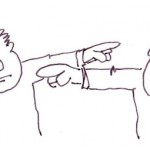Coaching New Leaders Part 5: The “no-blame” game
 Jerry Murphy is guest blogger of a series of six posts focused on coaching new leaders. The series will run consecutively. Read about Jerry below.
Jerry Murphy is guest blogger of a series of six posts focused on coaching new leaders. The series will run consecutively. Read about Jerry below.
One of a manager’s most challenging and rewarding situations is working with someone who is becoming a manager herself—either a first-time manager or taking on a new leadership position.
In this series of posts, I identify opportunities for you to use a coaching orientation to help you facilitate this transition for any of your people. This will help you to frame powerful questions, calibrating your “listening radar” for common issues, and offer appropriate suggestions for their consideration.
“Blame is just a lazy person’s way of making sense of chaos.” —Doug Coupland
Say the new manager you’re coaching has been appointed to replace the previous manager (“Bob”) who managed to screw everything up. Bob was let go, and everyone is relieved the new manager is aboard. Even though it’s her first leadership assignment, everyone is confident she will surely succeed since Bob left the place in such a mess. How could she not shine by comparison?
As her coach, you should sense danger ahead, so ask a few questions. Her inexperience may lead the new manager to immediately distinguish herself as a savior by blaming Bob as an incompetent. She might be correct in her assessment, but she should not share it. You can help set her on the right track by asking, “What can you learn from Bob?”
Learning from Bob
The new manager is inheriting a legacy of problems that should be perfectly clear to everyone, especially her team. They had to deal with Bob’s failures every day, and they know them better than anyone. So there is no point in the new manager being high-handed about Bob’s inadequacy until she has taken a step or two in his shoes and tried to deal with what he has left behind.
Instead, this is a great opportunity for her to learn from Bob. Who are these team members he’s been working with? Are there low-performers who need coaching or removal? Are there frustrated high-performers? What opportunities did Bob miss? What trade-ffs did he face? What were the real root causes of his mess-up?
“What can we learn from Bob?” is also a great question for the manger to explore immediately with her team, before the dust has settled. This discussion will provide an invaluable window on the situation, the team members, and possible solutions. It will also model the high-level leadership skill of learning from mistakes. In Good to Great, Jim Collins cites “autopsies without blame” as a ritual of high-performing teams and companies. The new manager’s situation is a perfect opportunity to establish this ritual in the team.
Diagnosis/solution
After a careful diagnosis, the manger needs to quickly identify the big problems and deliver the bad news to her superiors. This will define Bob’s legacy, so she won’t “own” any of his problems later. Then she should present her proposed solutions and a plan for implementing them. She will face problems of her own before long, but she needs to start by correcting those that Bob created.
A clear-eyed assessment of the situation a a plan to put the team on the right course will demonstrate to her superiors that they have appointed a capable problem-solver, and her team will quickly discover that they now have a results-oriented leader. Blame has no place in the equation.
Blame is all too common in organizational life. Have you found ways for coaching to cut through blame to identify problems and uncover real solutions?
If you found this post helpful, check out “About the Book” on this blog, and order yourself a copy of “What could happen if you do nothing?” A manager’s handbook for coaching conversations.
 Jerry Murphy is president of Giraffe LLC, a New York-based consulting practice, and Giraffe Business Publishing, a multimedia publishing venture. He serves an international client group of business leaders, teams, and organizations in improving their performance through coaching, leadership development programs, and organizational learning and development.
Jerry Murphy is president of Giraffe LLC, a New York-based consulting practice, and Giraffe Business Publishing, a multimedia publishing venture. He serves an international client group of business leaders, teams, and organizations in improving their performance through coaching, leadership development programs, and organizational learning and development.








